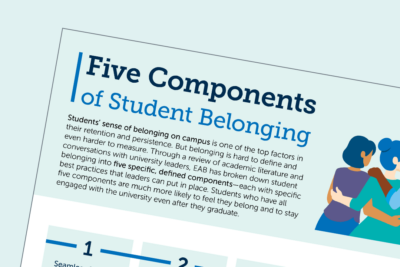Is Your College Designed for Post-Traditional Learners?
Since the peak of the recession, community colleges have experienced steady declines in enrollment of adult learners. While students flooded classrooms during the recession to upskill or retrain for new careers, today’s strong labor market has led to complacency about the need to prepare for the next economic downturn.
To demonstrate the value of education during economic upswings, colleges must show students that enrollment is feasible alongside other responsibilities and will make them less vulnerable in the future.
Our white paper outlines how community colleges can adapt to the needs of prospective and stopped-out students. Download the white paper for specific strategies to retain and engage post-traditional learners, from ensuring students are in the right program of study for their career goals, to making student services more accessible and aligning curricula with student goals and local labor market expectations.
Download the full toolkit or explore each section below.
This resource is part of the Diversity, Equity, Inclusion and Justice Initiatives in Higher Education Resource Center.
Section 1: Post-traditional is today’s student
The traditional image of an 18-year-old student who is dependent on his or her parents is less common now than in the past. Instead, students are older, more likely to attend part-time, have their own families, and work. In this section, learn more about the characteristics and challenges of post-traditional learners.
Section 2: Importance of early career advising
This section outlines strategies to understand students’ motivations for attending college to support their individual needs and career goals.
Retention strategy 1: Self-directed early career assessment
Retention strategy 2: Tools for informed decision-making
Retention strategy 3: Road maps for the future, planned with realistic expectations
Section 3: Adapting the college to working students
Faculty and administrative practices play an integral role in post-traditional students’ sense of belonging. In this section, discover community college practices that are responsive to the needs of working students.
Retention strategy 4: Services that engage off-campus students
Retention strategy 5: Course schedule crafted for students’ availability
Retention strategy 6: Classroom adaptation through the use of technology
Section 4: Post-traditional learners’ employment preparation
Most student services are typically offered during the day, when many post-traditional students are working. Use these ideas to give adult students with busy schedules the career preparation they need.
Retention strategy 7: Federal Work Study as practice experience
Retention strategy 8: Apprenticeships in industry
Retention strategy 9: Partnerships with workforce development boards and community-based organizations
Retention strategy 10: Career-preparation workshops in flexible formats
Retention strategy 11: Employer-student networking during nonworking hours
Retention strategy 12: Professional skills as course content
Retention strategy 13: Stackable credentials that are market-recognized and maintain momentum
More Resources

5 components of student belonging

Trends in Student Affairs Responses to Anti-DEI Legislation
